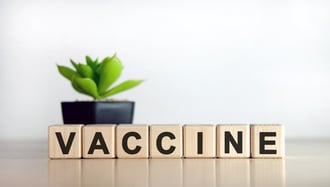What's Better Than Curing a Disease? Never Getting it in the First Place!

A vaccine is a way to build your body’s natural immunity to a disease before you get sick. This keeps you from getting and spreading the disease. Some vaccines like COVID-19 are new, but some vaccines have been available for nearly 200 years. The first vaccine was for smallpox, and it was widely used in Britain and the United States way back in the 1840’s! Since then, many more vaccines have become available, especially in the past 50 years.
Click here to watch a short video on the importance of vaccinations.
Preventing Severe Disease and Death
Vaccines prevent the spread of contagious, dangerous, and deadly diseases. These include measles, polio, mumps, chicken pox, whooping cough, diphtheria, tetanus, meningitis, HPV, shingles, pneumonia, Hepatitis A, Hepatitis B, and COVID-19. For children born in the United States during the period of 1994–2013, it is estimated that vaccines have prevented 322 million illnesses, 21 million hospitalizations, and 732,000 premature deaths.
Most diseases that vaccines protect us from still exist and can be passed on to those who have not been vaccinated. Most people don’t know much about diseases such as measles, mumps, and diphtheria because vaccination has been so successful. However, without vaccination these diseases, now uncommon in the US, can be transmitted to the unvaccinated from people traveling from other countries.
Vaccines Can Eliminate Diseases
There were 300 million-500 million deaths from smallpox, but with vaccination, the disease has been entirely eliminated from the planet. We are close to eradicating polio but still have work to do.
Vaccines Have Increased Lifespans
The average lifespan in developed countries 100 years ago was 47. Now it is 80. Vaccines have been a large contributor to this.
How Do Vaccines Work?
Some vaccines contain a weakened virus, a killed virus, or only proteins from the agent causing the infection. When injected, your body recognizes the virus or protein as foreign and produces antibodies. The antibodies attack the infection and inactivate it.
Newer vaccines contain mRNA (messenger ribonucleic acid) and are designed to have your body produce a key protein unique to the infectious agent instead of directly injecting the protein. The protein is produced for only a short time, and the messenger RNA dissolves. (The mRNA doesn’t affect the DNA that codes for all proteins in the body.) The body then produces antibodies in the same way. Traditional vaccines required the time intensive process of growing large amounts of virus. Newer mRNA vaccines can be designed and manufactured faster, can be adjusted quickly to adapt to changes in the target protein, and don’t contain any virus at all.
Are Vaccines Safe?
Vaccines go through vigorous testing before the FDA approves them, and monitoring continues even after they are approved. Reactions are usually mild and consist of local reactions such as redness, swelling, and tenderness at the site of the injection. Generalized reactions include fever, muscle aches, and fatigue. Side effects generally go away in a few days. These side effects are minor compared to what can happen if you get the disease the vaccine is protecting you from.
What Does the Future Hold?
Vaccines are in development for several infectious diseases including Lyme Disease, Respiratory Syncytial Virus (RSV), Epstein Barr Virus, Zika, Cytomegalovirus, and Hepatitis C. For further information on RSV, check out our blog HERE. Even more exciting is that new technologies hold the promise for vaccines to help with cancer, heart disease, and autoimmune diseases.
Clinical Trials
Chase Medical Research has experience in conducting trials for vaccines including Respiratory Syncytial Virus, Influenza, and Lyme Disease. If you are interested in participating in one of our trials, please check out our website for currently enrolling trials. We also have trials for many other conditions including migraines, diabetes, cardiovascular disease, chronic kidney disease, osteoarthritis, and obesity.
References:
- CG Whitney, F Zhou, J Singleton, A Schuchat, Benefits from immunization during the vaccines for children program era—United States, 1994–2013. MMWR Morb Mortal Wkly Rep 63, 352–355 (2014).
- Reasons for adults to be vaccinated (2022) Centers for Disease Control and Prevention. Centers for Disease Control and Prevention. https://www.cdc.gov/vaccines/adults/reasons-to-vaccinate.html
- S Plotkin, History of vaccination. Proc Natl Acad Sci USA 111, 12283–12287 (2014).
- Vaccines: Science, health, longevity, and wealth. Rappouli. Rino, PNAS, Vol 111, No 34, 8/19/2014. https://www.pnas.org/doi/10.1073/pnas.1413559111
- Vavilovskii Zhurnal Genet Selektsii., mRNA technology as one of the promising platforms for the SARS-CoV-2 vaccine development , 2020 Nov; 24(7): 802–807, Pub Med Central 8094037. https://www.ncbi.nlm.nih.gov/pmc/articles/PMC8094037/
Share This Post
Recent Posts
- The Relationship Between Obesity and Obstructive Sleep Apnea May 10 2023
- Cardiovascular Outcome Clinical Trials May 10 2023
- Diabetic Peripheral Neuropathic Pain May 10 2023
- Are All Types of Cholesterol Bad? May 10 2023
- Blood Pressure: The Highs, the Lows, and Everything in Between May 10 2023
Categories
- Clinical Trials
- Cardiovascular Disease
- Diabetes
- Obesity
- Kidney Disease
- Hypertension
- Pain Management
- Vaccine
- Cholesterol
- Chronic Obstructive Pulmonary Disease
- Diabetic Peripheral Neuropathy
- Migraine
- Osteoarthritis
- Biologics
- COVID-19
- Gastroesophageal Reflux Disease
- Irritable Bowel Syndrome with Constipation
- Lyme Disease
- Nonalcoholic Steatohepatitis
- Respiratory Syncytial Virus



